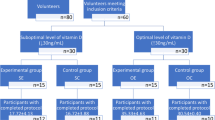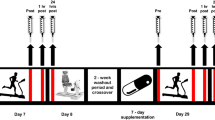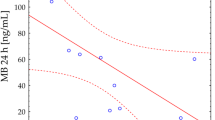Abstract
We have previously shown that vitamin C supplementation affects recovery from an unaccustomed bout of demanding exercise, with the most pronounced effect being that on plasma interleukin-6 concentration. However, because of the proposed role of interleukin-6 in the regulation of metabolism, it was unclear whether this represented a reduced response to muscle damage or some form of interaction with the metabolic demands of the activity. Therefore, the aim of the present study was to investigate the effect of the same form of supplementation on a bout of exercise that initiated similar muscle damage but had a low metabolic cost. Fourteen male subjects were allocated to either a placebo (P) or a vitamin C (VC) group. The VC group consumed 200 mg of ascorbic acid twice a day for 14 days prior to a bout of exercise and for the 3 days after exercise. The P group consumed identical capsules that contained 200 mg lactose. Subjects performed 30 min of downhill running at a gradient of −18% and recovery was monitored for up to 3 days after exercise. Plasma VC concentrations in the VC group increased following supplementation. Nevertheless, downhill running provoked a similar increase in circulating markers of muscle damage (creatine kinase activity and myoglobin concentration) and muscle soreness in P and VC groups. Similarly, although downhill running increased plasma interleukin-6, there was no effect from VC supplementation. These results suggest that vitamin C supplementation does not affect interleukin-6 concentrations following eccentric exercise that has a low metabolic component.




Similar content being viewed by others
References
Borg G (1982) Psychophysical bases of perceived exertion. Med Sci Sports Exerc 14:377–381
Croisier J, Camus G, Venneman I, Deby-Dupont G, Juchmes-Ferir A, Lamy M, Crielaard J, Deby C, Duchateau J (1999) Effects of training on exercise-induced muscle damage and interleukin 6 production. Muscle Nerve 22:208–212
Duarte J, Appell H, Carvalho F, Bastos M, Soares J (1993) Endothelium-derived oxidative stress may contribute to exercise-induced muscle damage. Int J Sports Med 14:440–443
Febbraio MA, Pedersen BK (2002) Muscle-derived interleukin-6: mechanisms for activation and possible biological roles. FASEB J 16:1335–1347
Fielding R, Manfredi T, Ding W, Fiatarone M, Evans W, Cannon J (1993) Acute phase response in exercise III. Neutrophil and IL-1β accumulation in skeletal muscle. Am J Physiol 265:R166–R172
Grimble R (1996) Interaction between nutrients, pro-inflammatory cytokines and inflammation. Clin Sci 91:121–130
Hellsten Y, Frandsen U, Ørthenblad N, Sjødin B, Richter E (1997) Xanthine oxidase in human skeletal muscle following eccentric exercise: a role in inflammation. J Physiol (Lond) 498:239–248
Jakeman P, Maxwell S (1993) Effect of antioxidant vitamin supplementation on muscle function after eccentric exercise. Eur J Appl Physiol 67:426–430
Lapointe BM, Frenette J, Cote CH (2002) Lengthening contraction-induced inflammation is linked to secondary damage but devoid of neutrophil invasion. J Appl Physiol 92:1995–2004
Levine M, Conry-Cantilena C, Wang Y, Welch R, Washko P, Dhariwal K, Park J, Lazarev A, Graumlich J, King J, Cantilena LR (1996) Vitamin C pharmacokinetics in healthy volunteers: Evidence for a recommended dietary allowance. Proc Natl Acad Sci USA 93:3704–3709
MacIntyre D, Reid WD, McKenzie DC (1995) Delayed muscle soreness: the inflammatory response to muscle injury and its clinical implications. Sports Med 20:24–40
MacIntyre D, Reid W, Lyster D, Szasz I, McKenzie D (1996) Presence of WBC, decreased strength, and delayed soreness in muscle after eccentric exercise. J Appl Physiol 80:1006–1013
Maughan RJ, Donnelly AE, Gleeson M, Whiting PH, Walker KA, Clough PJ (1989) Delayed-onset muscle damage and lipid peroxidation in man after a downhill run. Muscle Nerve 12:332–336
Nicholas CW, Tsintzas K, Boobis L, Williams C (1999) Carbohydrate-electrolyte ingestion during intermittent high- intensity running. Med Sci Sports Exerc 31:1280–1286
Nicholas CW, Nuttall FE, Williams C (2000) The Loughborough Intermittent Shuttle Test: A field test that simulates the activity pattern of soccer. J Sports Sci 18:97–104
Nieman DC, Peters EM, Henson DA, Nevines EI, Thompson MM (2000) Influence of vitamin C supplementation on cytokine changes following an ultramarathon. J Interferon Cytokine Res 20:1029–1035
Petersen EW, Ostrowski K, Ibfelt T, Richelle M, Offord E, Halkjaer-Kristensen J, Pedersen BK (2001) Effect of vitamin supplementation on cytokine response and on muscle damage after strenuous exercise. Am J Physiol 280:C1570–C1575
Schwane J, Johnson S, Vandenakker C, Armstrong R (1983) Delayed-onset muscular soreness and plasma CPK and LDH activities after downhill running. Med Sci Sports Exerc 15:51–56
Shephard RJ, Shek PN (1998) Immune responses to inflammation and trauma: a physical training model. Can J Physiol Pharmacol 76:469–472
Smith L (1991) Acute inflammation: the underlying mechanism in delayed onset muscle soreness? Med Sci Sports Exerc 23:542–551
Sorichter S, Mair J, Koller A, Gebert W, Rama D, Calzolari C, Artner-Dworzak E, Puschendorf B (1997) Skeletal troponin I as a marker of exercise-induced muscle damage. J Appl Physiol 83:1076–1082
Thomas JR, Salazar W, Landers DM (1991) What is missing in p<0.05? Effect Size. Res Q Exerc Sport 62:344–348
Thompson D, Nicholas CW, Williams C (1999) Muscle soreness following prolonged intermittent high-intensity shuttle running. J Sports Sci 17:387–395
Thompson D, Williams C, Kingsley M, Nicholas CW, Lakomy HKA, McArdle F, Jackson MJ (2001a) Muscle soreness and damage parameters after prolonged intermittent shuttle-running following acute vitamin C supplementation. Int J Sports Med 22:68–75
Thompson D, Williams C, McGregor SJ, Nicholas CW, McArdle F, Jackson MJ, Powell JR (2001b) Prolonged vitamin C supplementation and recovery from demanding exercise. Int J Sport Nutr Exerc Metab 11:466–481
Thompson D, Williams C, Garcia-Roves P, McGregor S, McArdle F, Jackson MJ (2003) Post-exercise vitamin C supplementation and recovery from demanding exercise. Eur J Appl Physiol 89:393–400
Vassilakopoulos T, Karatza M-H, Katsaounou P, Kollintza A, Zakynthinos S, Roussos C (2003) Antioxidants attenuate the plasma cytokine response to exercise in humans. J Appl Physiol 94:1025–1032
Weiss S (1989) Tissue destruction by neutrophils. N Engl J Med 320:365–376
Williams C, Nute M, Broadbank L, Vinall S (1990) Influence of fluid intake on endurance running performance. Eur J Appl Physiol 60:112–119
Willoughby DS, McFarlin B, Bois C (2003) Interleukin-6 expression after repeated bouts of eccentric exercise. Int J Sports Med 24:15–21
Author information
Authors and Affiliations
Corresponding author
Rights and permissions
About this article
Cite this article
Thompson, D., Bailey, D.M., Hill, J. et al. Prolonged vitamin C supplementation and recovery from eccentric exercise. Eur J Appl Physiol 92, 133–138 (2004). https://doi.org/10.1007/s00421-004-1064-y
Accepted:
Published:
Issue Date:
DOI: https://doi.org/10.1007/s00421-004-1064-y




